
Introduction
The profitability of commercial aircraft is a crucial factor in the aviation industry’s economics. Airlines must choose aircraft that balance initial investment, operational efficiency, maintenance costs, and customer satisfaction to ensure long-term financial success. In this article, we will explore the key components that contribute to commercial aircraft profitability, helping industry professionals, investors, and aviation enthusiasts understand the dynamics behind aircraft selection and operation.
1. Operating Cost Efficiency
Operating cost efficiency is one of the most fundamental metrics determining the profitability of a commercial aircraft. Airlines measure this based on direct operating costs, including fuel, crew salaries, maintenance, and airport fees.
a. Fuel Efficiency
Fuel is one of the largest ongoing expenses for any airline. Aircraft that can minimize fuel consumption per mile flown significantly improve overall cost performance.
- New-generation engines such as Pratt & Whitney’s GTF and CFM International’s LEAP offer higher fuel efficiency.
- Lightweight materials like carbon fiber-reinforced polymers reduce the aircraft’s weight, contributing to fuel savings.
- Aerodynamic improvements, such as sharklets and winglets, help reduce drag and improve efficiency.
For example, the Airbus A350 and Boeing 787 are among the most fuel-efficient wide-body aircraft, leading to strong financial performance on long-haul routes.
b. Maintenance and Reliability
Aircraft that require less frequent or intensive maintenance reduce costs and improve aircraft utilization.
- Predictive maintenance technologies allow airlines to anticipate and resolve issues before they cause delays.
- Highly reliable systems mean fewer delays, cancellations, or unscheduled repairs.
- Manufacturers with strong after-sales service and global parts availability (like Boeing and Airbus) provide a financial advantage to airlines.
Efficient maintenance planning also ensures the aircraft spends more time in the air generating revenue rather than on the ground undergoing repairs.
2. Route Flexibility and Range Performance
Profitability is closely tied to an aircraft’s ability to serve a diverse range of routes effectively.
a. Short-Haul vs. Long-Haul Capabilities
Aircraft optimized for specific route types allow airlines to match capacity and performance with demand.
- Regional jets such as the Embraer E-Jet series are ideal for short-haul and low-demand routes.
- Long-haul aircraft like the Boeing 777X can cover intercontinental distances while offering high capacity.
Having the right aircraft for the right route minimizes overcapacity and underutilization, two key drivers of financial loss.
b. Airport Accessibility
Aircraft that can operate from a wider variety of airports provide more network opportunities.
- Short takeoff and landing (STOL) capabilities allow access to smaller or remote airports.
- Noise restrictions and emissions compliance improve access to environmentally regulated airports.
Flexibility in operations lets airlines tap into underserved markets, increasing load factors and profitability.
3. Passenger Experience and Cabin Configuration
An aircraft’s interior design and comfort level can directly impact customer satisfaction, loyalty, and revenue generation.
a. Seating Configuration and Revenue Optimization
The way an aircraft cabin is configured has a strong influence on revenue per available seat mile (RASM).
- High-density seating increases capacity on short-haul routes where ticket prices are lower.
- Premium cabins (business/first class) offer higher margins on long-haul routes.
- Modular cabin designs allow quick reconfiguration between premium and economy classes.
For example, airlines like Qatar Airways and Singapore Airlines have capitalized on luxurious business class offerings to differentiate themselves and drive profits.
b. In-Flight Amenities and Comfort
Modern passengers value in-flight comfort and connectivity.
- Features like wider seats, mood lighting, quieter cabins, and better air filtration improve passenger satisfaction.
- In-flight Wi-Fi and entertainment systems cater to both business and leisure travelers.
Satisfied passengers are more likely to choose the same airline again, improving brand loyalty and reducing marketing costs per acquisition.
4. Fleet Commonality and Scalability
Operating a fleet with high commonality helps airlines streamline operations and reduce costs.
a. Pilot and Crew Training
Training pilots and crew for one aircraft type is significantly more cost-effective than maintaining proficiency across multiple models.
- Similar cockpits across variants (e.g., Airbus A320 family) allow cross-crew qualification.
- Reduced training costs and increased scheduling flexibility improve operational efficiency.
Airlines such as Southwest Airlines benefit from this strategy by operating an all-Boeing 737 fleet.
b. Spare Parts and Maintenance Synergy
Fleet commonality reduces the number of spare parts required and simplifies maintenance planning.
- Shared components among aircraft types allow bulk purchasing and better inventory control.
- Maintenance staff can be trained for a narrower range of systems.
This synergy translates into tangible cost savings over time, boosting long-term profitability.
5. Aircraft Acquisition and Lifecycle Value
The upfront cost of an aircraft and its residual value at the end of its service life are critical financial considerations.
a. Purchase Price and Financing Options
Airlines need to balance between acquiring aircraft outright or leasing them.
| Acquisition Type | Pros | Cons |
|---|---|---|
| Purchase | Lower long-term cost | High upfront investment |
| Operating Lease | Flexibility, lower initial cost | Higher long-term cost |
| Finance Lease | Ownership after lease period | Complex financial arrangements |
Aircraft that hold their value well or are easily remarketed provide better financing terms and reduce long-term capital risk.
b. Depreciation and Residual Value
Some aircraft models depreciate slower than others, which can have a major impact on balance sheets.
- Aircraft with a broad global operator base tend to retain value better.
- Popular models like the Boeing 737 and Airbus A320 have strong secondary markets.
Minimizing depreciation helps maintain better equity ratios and improves the airline’s overall financial health.
Conclusion: The Flight Path to Profitability
Making a commercial aircraft profitable is about more than just choosing the latest model. Airlines must consider operating costs, route fit, passenger appeal, fleet synergy, and lifecycle value. Each of these factors influences how well an aircraft contributes to a carrier’s bottom line.
Ultimately, profitability comes from aligning the aircraft’s capabilities with the airline’s strategy and market conditions. By understanding these key aspects, airline executives and planners can make more informed decisions that benefit their business long-term.